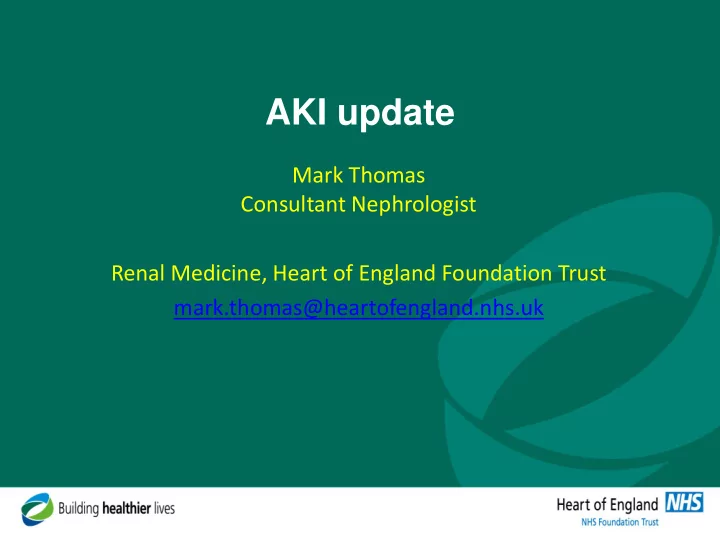

AKI update Mark Thomas Consultant Nephrologist Renal Medicine, Heart of England Foundation Trust mark.thomas@heartofengland.nhs.uk
AKI update • Transfer protocols • Possible regional AKI collaboration • Unreferred stage 3s • (new NICE indicators)
http://www.londonaki.net/clinical/guidelines-pathways.html
Interhospital transfer of AKI Level 1 ward patient
Interhospital transfer of AKI Improving Level 3 ITU patient - remaining dialysis dependent
London AKI Network Manual v2.0 - 2015 Overview – page 4 • Transfer target to kidney unit is 24 hours – but there are currently heavy demands on acute renal bed usage at some sites • Temporary lowering of K with insulin and dextrose does not facilitate safe transfer – there may be rebound in transit – hyperkalaemic patients should have onsite CVVH or bicarbonate prior to transfer such that the K lowering is likely to be sustained.
Single organ failure AKI audit • Included: – All dialysis dependent AKI where first dialysis was haemodialysis in HEFT Renal unit 2000 - 2015 – Empirical diagnosis of AKI or “Acute” status by treating clinician is relied upon – Thus AKI primarily under care of nephrology at start – Included even if they later went to ITU – n = 1389 or about 87 per year on average – Grouped together in two year eras • Excluded – Patients who started with CRRT on ITU – Prior transplants – Therapeutic plasma exchange only
Rules for SOF AKI coding • Patients who had recovered from a previous dialysis dependent AKI episode included • First outcomes examined – “Recovery” – partial or complete • No longer dependent on RRT • Clinic, Low clearance clinic, or Conservative clinic patients deemed to have recovered sufficiently to allow no RRT – Non recovery: switch from acute dialysis to Chronic RRT • HD, PD – Death whilst still undergoing acute RRT
What units would need to develop Regional comparisons • Agreement on rules amongst all participating units, consultants and senior nurses • Some coding education for all nurses dealing with “ Acutes ” • Lead consultant • Data manager time – Modest extra work once coding rules agreed – Some data cleaning • Remove ITU cases, if any • Remove TPE alone • Remove Transplant patients
We’re not the Renal Registry • Have a very limited minimum dataset to be agreed by leads • Each unit to review its own data internally first • Plan perhaps to review aggregate dataset in 6 or 12 months after coding agreed • ? Take plan to UKRR first or later • Adjust for age, diabetes (comorbidity…..??) • Length of stay (optional?)
Local audit conclusions • There are rising numbers of diabetics • Survival may have improved at the expense of more “chronic” patients • A regional QuIP focusing on AKI receiving haemodialysis would be possible • It would require modest work at a local level
Proposed NICE indicator menu additions CCG5: Diagnosis rate of AKI within a CCG population • This will have to be supplied via UKRR from Trust laboratories CCG6: Admission rates due to AKI • This is community acquired AKI. Currently in the UK this cannot be determined by coding as there is no “Present on admission” (POA) indicator in use in UK hospital coding. Therefore this indicator is not practical and poorly thought through, until coding practice is changed in the UK. CCG7: The proportion of people diagnosed with AKI who require specialist • care: – Renal replacement therapy – Critical care This should be modified to: – Renal replacement therapy outside critical care – Renal replacement therapy within Critical care – This is because the current ICNARC database for all ITUs only collects use of RRT and not all AKI; collecting data on AKI leading to critical care would require a change in a National Database
Proposed NICE indicator menu additions • CCG8 : Length of stay for people diagnosed with AKI • CCG9 : Hospital re-admission rates where AKI is coded within 30 days of discharge from hospital • CCG10 : The proportion of people who experience a repeat admission due to AKI within 12 months of a previous episode of AKI These three indicators require extra IT resources within acute Trusts, at a time when such resources are being cut. • CCG11 : The proportion of people with AKI who go onto develop CKD This requires long term linkage of AKI events to later kidney function testing. It is of interest to the NHS, but is a research question and not suitable as an indicator.
Recommend
More recommend